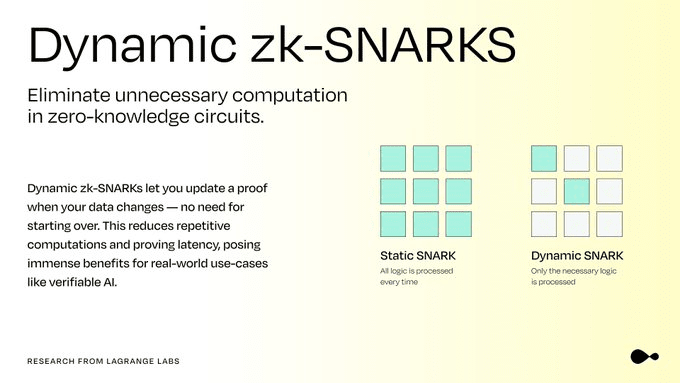In recent months, I've been pondering a question: Where will the next singularity of Web3 be? We have faster L2s and more modular designs, but it seems like something is still missing. Have we all gotten too accustomed to it? Accustomed to the idea that complex tasks should be done off-chain, and then a simple result (like a price) is fed on-chain through an oracle. This model has run for quite some time and has contributed significantly to DeFi.
But what if... the chain itself could 'think' about those truly complex problems? What if your smart contract could run an AI model, handle a whole set of complex game physics engines, and analyze massive amounts of on-chain data?
Today, I want to talk to you about a project that gives me this feeling — Lagrange.
To be honest, when I first came across it, I thought it was just another complex ZK project filled with mathematical formulas and inaccessible to most. But when I truly delved deeper, I found a particularly interesting perspective, a moment that made me say 'Aha!':
Lagrange can be understood as a 'general computational oracle.'
The Chainlink we are familiar with is a 'price oracle' that tells you 'What is the current price of ETH?'. In contrast, Lagrange is a 'computational oracle' that is responsible for answering 'Based on this 1TB of on-chain data, what is the result of running this complex machine learning model?'

How can it achieve this? — Verifiable 'external brain'
We all know that blockchain itself is like a meticulous but somewhat slow accountant. If you ask it to keep books or transfer funds, it does so meticulously, but asking it to perform calculus is just an extravagant wish in terms of cost and time. This is the so-called 'on-chain computation bottleneck.'
Lagrange's solution is both clever and bold. It does not propose to create a new chain by itself but chooses to equip all existing blockchains (such as Ethereum, Solana, etc.) with a trustworthy 'external brain.'
The workflow of this brain probably looks like this:
Task outsourcing: Smart contracts outsource a 'brain-burning' computation task (like 'calculate the specific impermanent loss value for all Uniswap V3 LPs of a certain trading pair over the past 30 days') to Lagrange.
Parallel computation: Lagrange has a design called 'State Committees' that can be imagined as countless small calculators. They sync to the latest 'state' from the corresponding blockchain (like Ethereum) and then process this complex computational task in parallel. This allows for extremely fast processing speeds.
Generating 'receipts': After the computation is complete, Lagrange does not give you a bare result directly. Instead, it uses zero-knowledge proofs (ZK Proof) to generate an irrefutable, extremely concise computational 'receipt.'
On-chain verification: This ZK 'receipt' is returned to the smart contract on the main chain. The contract does not need to recalculate that complex task; it only needs to verify the authenticity of this 'receipt,' which is extremely low-cost and fast.
It's like you don't need to read through an entire obscure tome of physics yourself; a top team of physicists (Lagrange) directly gives you a verifiable, absolutely correct final conclusion and a summary of its proof process (ZK Proof).

What is the use of this? — From 'half-baked' chain games to real on-chain AI
This is not just a technical showcase; it truly opens up the imaginative ceiling for Web3 application scenarios.
🔸 Truly Fully On-chain GameFi:
Currently, most core logic in chain games still runs on centralized servers, with only assets on-chain, leading to a disjointed experience. Imagine if the physics engine of an MMORPG, the behavior logic of AI NPCs, and even the evolution of the entire game world could be verified through on-chain computation using Lagrange. That would be a truly decentralized world driven by code and community, permissionless and never going down.
🔸 DeFi & Data Analysis:
More complex DeFi strategies will become possible. For instance, protocols that can dynamically analyze the overall on-chain market sentiment and automatically execute complex arbitrage strategies, or those that can provide users with verifiable and extremely complex credit scoring models. All of this no longer relies on centralized backend servers.
🔸 Web3 x AI & DePIN:
This is the aspect that excites me the most. AI models can be called by smart contracts on-chain to process vast amounts of DePIN node data and provide a verifiable result. For instance, a decentralized storage network can use Lagrange to verify whether nodes have truly stored the correct data, without each validator needing to download the complete data for comparison.
My real thoughts and questions
Talking about this makes me very excited because it perfectly aligns with two narratives I am very optimistic about: 'modular blockchains' and 'ZK everything.' The execution layer can continue to remain lightweight and fast while outsourcing increasingly heavy computational demands to 'co-processor' layers like Lagrange.
But at the same time, I also maintain a sense of calm and scrutiny:
Security and decentralization: How can the security of this 'heterogeneous trust' model (the main chain distrusts Lagrange's computational results) be guaranteed? The degree of decentralization and attack resistance of Lagrange's own network (especially the state committees) is crucial to its potential for large-scale adoption.
Economic model: Can the token economic model of running such a powerful computing network sustainably incentivize the addition of computational nodes while keeping it affordable for developers? This is a very delicate balance.
Market education: 'Computational oracle' is a very new concept, and the project team needs to invest a lot of time and effort to educate developers on what this can do and how to use it.
Overall, Lagrange is not a project that aims for short-term hype; it is trying to solve a very fundamental and foundational problem. Its success or failure will directly determine how much we can raise the ceiling of Web3 applications.
This is a 'slow variable' that deserves our long-term attention and tracking.



